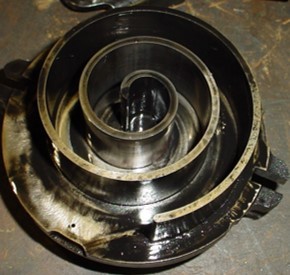
Discharge Temp Effects on Compressor Life
This topic has to do with the effects of discharge temperature on the compressor life expectancy. Like most of these topics, there is far more to it than just looking at one data point. Superheat is a big part of the puzzle. Compression ratio is another one and there are several others that affect discharge temperatures that need to be included as well. Some like suction pressure and superheat also affect winding temperature as well and can have a negative effect on life expectancy all on their own. We will look at factors that often affect real world examples and how best to correct them. To start with however, we need to look at what happens inside of the compressor as it does its thing.
Since the compressor compresses 100% vapor, there is no phase change occurring, only the reduction in volume and an increase in density of the vapor. This increases the energy of the of the vapor thru work and thus its temperature will rise in a sensible process. How much of a temperature increase depends on several factors which we can look at individually as they are all important factors and happen too often to ignore.
Compression ratio: Since the increase in temperature of the vapor during compression is heavily influenced by how much work is done on it, and work is the process of increasing the pressure and density, the greater the change in pressure and density the higher the final temperature of the vapor will be for a given suction condition. This can be seen by comparing the discharge temperatures of a R404A semi-hermetic compressor that is working with a -40 F Saturated Suction Temperature (SST), then -20 F SST and finally +20 F SST and all using a 110F condensing temperature with (15 F) superheat at the compressor suction . The estimated discharge temperatures would be 202 F, 184 F and 164 F respectively. Now 110 F condensing is not that high when one considers a roof temperature in the summer down south. In this condition, 130 F is not out of the question, especially if the coil is a little dirty. If we run the same evaporator conditions at a condensing temperature of 130 F, the discharge temperatures become 242 F, 213 F and 193 F respectively. Now 242 F is getting pretty warm and it is at these conditions that it is critical that the superheat present in the suction gas is limited as much as possible or as we will see below, excessive temperature can occur in several areas of the compressor.
Suction Superheat: When you look at the values from tables for setting high pressure controls or even the application envelope for a particular compressor, there is an assumption made concerning the amount of superheat present in the suction gas: It is not excessive. In fact it is pretty close to ideal. In other words, the expectation is that the system was installed correctly, has had the correct refrigerant charge added and there are no leaks or non-insulated 50 foot suction line runs in a hot unconditioned space. Why? Because for one, this is the way it should be done, and two, these would render the values given in the charts or tables as useless or pretty nearly so. If we run the number above for calculating discharge temperatures with a super heat value of 30 F instead of 15 at the compressor suction, the -40/130 system ends up with a discharge temperature of 256 F. This is pretty much right at the point where I would be getting worried and the reason has to do with the oil. Sure the oil may be good to a discharge temperature of 270 F or so, but this does not mean that it's viscosity is optimal or that there are not pockets of areas in the compressor where it is subjected to even high temperatures. Scroll compressors are an excellent example of this. The bearing temperature under the mobile scroll is critical to ensuring long compressor life as this bearing is directly adjacent to the hottest section of the compression section which is the center of the scrolls themselves. Any change in discharge temperature directly affects the temperature of this bearing. It is no coincidence that it is a major failure point.
System Charge: Even without going to the extremes of using a -40F SST, a typical low temp -10F SST/110F system can still end up with excessive discharge temperatures and just as important, motor winding temperatures as well. Charge loss, especially a slow one can cause the discharge temperature to climb to dangerous levels over an extended period of time. The main causes are the increase in compression ratio due to the quick drop in evaporator saturation temperature/pressure and the reduced mass of suction gas that is used to cool the compressor motor. Since there is less mass flow through the evaporator, the evaporator suction superheat value goes through the roof. And while the condensing temperature will drop due the reduced charge, the drop in the low side pressures are far greater and result in high compression ratios. Try using some compressor software and plug in -35F and a return gas temperature of 65F with a condensing temp of 100F. I did and got a discharge temperature of 260F. Normal discharge temperature would be It takes less refrigerant loss to drop a normal saturated -10F evaporator refrigeration system to -35F than you might think.
Business | Devops | HVAC | Fintech
4yGreat article and examples.
President at measureQuick (Manifold Cloud Services Ltd.)
4yAs always it’s always about mass flow when it comes to compressor cooling. Great article with excellent examples.
Principal Owner at HVAC Specialties TAC
4ySo hard to get some to understand the fundamentals. 👍
Carter Machinery - Technical Training Instructor
4yIncredible Jamie! I really appreciate your thorough explanation of the effects of low refrigerant charge, high superheat.